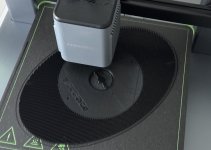Well, shucks. I see files downloaded on March 25th do have the holes, so I may have worked from older versions. When were they updated?
I'm not sure. I try to post an update entry at the top of the page when I make significant changes but I may not have on that page.
There is a better way than just holes, that aligns everything in one go and keeps the surround from making any strong contact
Last edited by a moderator:
I can't give you the file because I made it for someone else but I will check if they are OK with me sharing the sketch for the mount.Can you share the dimensions or .f3d file fluid?
Got it. The 6 inch files do have three tweeter mounting holes, whereas the 6.5 inch files do not. Unzipping 6x1 68 A T25 v2 stl.zip produces 6x1 68 A T25 v2.stl with a datestamp of September 25th 2022, whereas unzipping 65 vA step.zip generates 65 vA.step with a datestamp of June 7, 2022.
No big on my end, my setup works.
No big on my end, my setup works.
@fluid , what is the issue of strong contact on the surround?There is a better way than just holes, that aligns everything in one go and keeps the surround from making any strong contact
View attachment 1310259
On the Bliesma drivers the surrround is glued to the face plate and extents some way out from the roll. If a waveguide makes direct contact with the surround and it is tightened down enough it can cause the driver to misbehave and not perform as well as it can. @jcga had this problem early on when experimenting with waveguides. 3D printing has tolerances and it could be that the tolerance helps or hurts depending on where it is. I prefer to avoid finding out so in my designs there is either a small gap designed in or a spacer to put in place to make sure the surround isn't under pressure.@fluid , what is the issue of strong contact on the surround?
Other drivers don't seem to be designed in quite the same way. The SB26 you are looking to use does not seem to care and SB's own faceplate design does not avoid contact with the glued part.
Understood,
Wrt sb26adc, the surround is indeed glued to a plastic plate, and its (not very massive) faceplate then has a ring and 4 studs (protuding the same depth as far as i can measure) that sort of mount this plastic plate as well. All in all not a very solid/ridgid mounting.
I just measured the impedance of one of my wg versions, and i only see a resonance at ~ 5kHz, presumably from the centerbore which has no form of damping at all. To be further investigated.
Wrt sb26adc, the surround is indeed glued to a plastic plate, and its (not very massive) faceplate then has a ring and 4 studs (protuding the same depth as far as i can measure) that sort of mount this plastic plate as well. All in all not a very solid/ridgid mounting.
I just measured the impedance of one of my wg versions, and i only see a resonance at ~ 5kHz, presumably from the centerbore which has no form of damping at all. To be further investigated.
I'm not sure, I haven't tried to to do anything about it. Would be interesting to see someone experiment.
Will do. The 4" waveguide, modified to fit my "upgrade path" to a purifi tweeter.


Plan is to measure its response in cabinet tomorrow.
Plan is to measure its response in cabinet tomorrow.
An ovale waveguide in a bigger faceplate.Will do. The 4" waveguide, modified to fit my "upgrade path" to a purifi tweeter.
View attachment 1310395View attachment 1310396
Plan is to measure its response in cabinet tomorrow.
It looks great, but doesn't that defeat the purpose of the ovale shape?
Aka, being closer to the mid-woofer.
I found one comparison, but this one does not have the low frequency, near field response merged with the far field. So disregard response below 220hz on my measurement. This was the Satori MW16TX and Bliesma T25B on waveguide.
View attachment 1308112
Why that big difference >7kHz? Klippel measurement >20kHz is for sure not correct - even the plain T25B is not straight to 50kHz.
What mic did you use? 50kHz has a BIG resonance, your mic seem to already dampen >35-40kHz?
Yes, and i did akabak sims on axi- symmetric version, but did not have the time to test given the deadline then.
However, the deadline i had will not be achieved , due to priorities in the family and poor weather.
So i kept the oval one, for now.
The c2c is 130mm by the way.
However, the deadline i had will not be achieved , due to priorities in the family and poor weather.
So i kept the oval one, for now.
The c2c is 130mm by the way.
Why that big difference >7kHz? Klippel measurement >20kHz is for sure not correct - even the plain T25B is not straight to 50kHz.
What mic did you use? 50kHz has a BIG resonance, your mic seem to already dampen >35-40kHz?
Klippel cuts off at 20hz and 20khz, so the response above and below that is just padding. OTOH I don't know that trust my mic cal file above 22khz, so the T25B on waveguide does have a rising response up high, but other than I can't really say how high the SPL actually is. I use an ECM8000 for measurements. I also have ECM6 and Sonarworks Ref 1 (I think that's the model). All very close with their cal files used.
- Home
- Loudspeakers
- Multi-Way
- Open source Waveguides for CNC & 3D printing!
